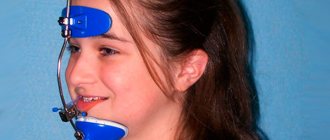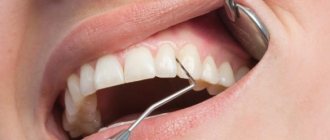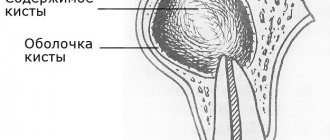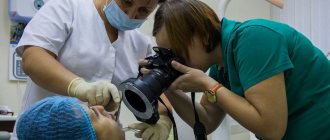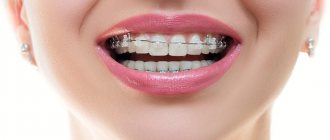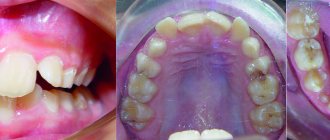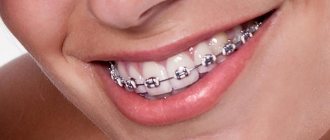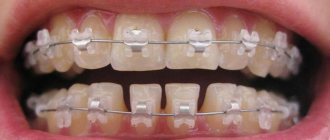Can I get braces at 30 or 40? This question is often asked to dentists by adult patients who have long dreamed of an attractive Hollywood smile. Thanks to innovative technologies, teeth straightening and bite correction today have no age restrictions. Modern fixed appliances allow the formation of an even dentition for both children and adults. It’s just that the same braces at different ages will solve different problems. Let's figure out together how exactly therapy for children and adolescents differs from the treatment prescribed to their mothers and fathers.
Is it possible to straighten teeth without braces?
Any orthodontist knows well that parents who bring their heirs to an appointment always insist on installing braces, knowing full well how important the image role of a perfect smile is in our society. When it comes to straightening their own teeth, many try to limit themselves solely to masking existing anomalies with the help of ceramic veneers or lumineers. This is one of the significant features of adult patients.
But the laws of orthodontics do not depend on a person’s age. Therefore, neither an abnormal bite nor crowded teeth can be corrected by aesthetic dentistry. “Just straightening up your front teeth,” as an elegant lady aged 35+ wants, will not work if the reason for their protruding forward is a pathological bite. Whether you like it or not, you will have to wear braces.
Myth No. 1. Correcting an overbite is very painful.
This is greatly exaggerated. Most patients who wear braces note that they felt some discomfort for the first 2-3 days after installation/activation. The level of this discomfort is individual and depends on the person’s pain sensitivity threshold. In the vast majority of patients, the intensity of pain is minimal. Some sensitivity when eating at first is normal, choose something softer to reduce the stress.
In the vast majority of patients, the intensity of pain when wearing braces is minimal.
At what age is it easiest and fastest to get the desired result?
As a rule, an orthodontist will recommend putting braces on a child at the age of 10–12 years, when the formation of the maxillofacial apparatus is completed and the body is in the stage of active growth. But quite often doctors have to carry out corrections for preschoolers using removable orthodontic structures or postpone treatment with braces until they reach 16–18 years of age.
- Faster results of correction in adolescence are explained by greater compliance of the jaw bone.
- In children with baby teeth, the desired result can often be achieved by wearing a removable mouthguard or trainer. In adults, the same devices cope with only the most minor anomalies.
- Moreover, children whose jaw is just developing benefit from massage and specialized gymnastics that train the muscles of the face and tongue.
There are other features that significantly increase the cost and prolongation of orthodontic treatment for adults and even make it impossible.
How long should you wear braces?
Another common fear of patients is always the duration of treatment. Despite all the promises of doctors and the testimony of other patients that the installation of the structure has practically no effect on the usual rhythm of life, it is always difficult to decide to correct teeth. It seems like I'll have to wear braces forever!
How long do you really need to wear braces? We have already said that in childhood, treatment is faster due to the characteristics of bone tissue, which is still pliable and ready for rapid changes. Therefore, for children, the period of wearing structures is about 6–12 months, and in complex cases or adolescence it can increase to 1.5 years.
For people 20–30 years and older, the average treatment period is 2 years. The teeth are already firmly fixed in their position, and it will be more difficult to move them from their place.
Don't forget that in dentistry everything is very individual. Your case may be exceptional and require unusual deadlines. It is also possible that the bite will correct itself faster than expected. For example, if self-ligating braces are used. The main thing is not to forget to visit the doctor strictly in accordance with his recommendations, so as not to miss the opportunity to shorten the treatment period.
Problems with teeth and gums are a feature of adult orthodontic patients
Is it possible to put braces on crowns and filled teeth? This question is extremely relevant for adults who have decided to undergo orthodontic treatment, because the condition of their teeth, and sometimes gums, very often leaves much to be desired. The process is often complicated by the presence of a large number of fillings placed long ago, pulpless teeth covered with crowns, and sometimes problems with periodontium. Therefore, a patient who comes for an appointment at the orthodontic center for the first time is prescribed a thorough diagnosis, and based on its results, a consultation with specialized specialists: a therapist, a periodontist, a surgeon.
- Ultimately, only the doctor decides whether to put braces on fillings. It all depends on the condition of the tooth enamel, the quality and service life of the filling. If necessary, the tooth is resealed to prevent the “historic” dental cement from cracking or splitting.
- The problem with crowns is also solved individually. Teeth covered with them can only be moved if their roots are not damaged. If the crown is part of a bridge, the bridge will have to be sawed to release it, or it will have to be removed and a temporary plastic prosthesis made for the patient. Since the surface of the crowns is smoother than tooth enamel, it is best for the patient to install metal braces in installments, which have a more reliable fixation.
Reasons to install braces after 40
Braces treatment is an investment in health and beauty. If at a young age the anomaly of malocclusion primarily disturbed the aesthetics of the face, then after 40 (perhaps even earlier) side pathologies appear in the body.
- Problems with diction are getting worse.
- As a result of uneven distribution of load between the dentition, the surface of the teeth is worn down. Defects, chips, and cracks form in the tooth enamel.
- An imbalance in the chewing load leads to inflammatory processes in the gums and carious formations on teeth that work beyond normal limits. The teeth decay and leave the jaw.
- The temporomandibular joint “wears out.” This provokes painful bursts, frequent crunching, clicking, tinkling. As people age, people with malocclusion are more likely to suffer from headaches and joint pain.
- The efficiency of chewing food decreases. Large particles of food are poorly digested and lead to the development of gastrointestinal pathologies.
- Prosthetics in perspective.
Is it possible to get braces if you have periodontitis?
Periodontitis, inflammatory gum disease, and malocclusion are two sides of the same coin.
- A malocclusion is often characterized by crowded teeth. At the same time, their high-quality cleaning from food debris and plaque is significantly difficult, and the likelihood of the formation of tartar, the main cause of periodontitis, is increased. Without eliminating the dental anomaly, it is impossible to cure inflammation of periodontal tissues.
- Of course, in the acute stage of the disease, orthodontic treatment cannot be carried out. The patient will first be prescribed professional teeth cleaning and therapeutic treatment, and only after that will the braces be installed.
Straightening teeth with braces for periodontitis has a number of distinctive features. In particular, the traction force of the orthodontic arch will be reduced, therefore, the treatment period will increase. You will also have to wear retainers longer than usual. In addition, the patient must especially carefully perform hygiene procedures. Only if these conditions are met, bite correction will play a positive role and stop the progression of periodontitis.
Unfortunately, significant degenerative processes in the periodontium, in particular, strong resorption of bone interradicular septa, can become a contraindication to bite correction with braces.
Braces in adults
The most favorable age range for correcting malocclusion is 12-18 years. During this period, all permanent teeth have already erupted, but the active growth phase continues. It is generally accepted that up to the age of 18, orthodontic treatment will take a minimum of time and be most effective. But it is not so. In many ways, the successful outcome of treatment and the time it takes to correct the bite depend on the patient: how responsibly he approaches the process, follows the recommendations of the orthodontist, and makes regular visits to the clinic. Adults are more scrupulous in this matter compared to teenagers, so wearing braces also brings the desired result.
Bite correction in adulthood is often indicated for patients not only for aesthetic reasons, although the desire to get a beautiful smile is in most cases the main reason for visiting an orthodontist. In addition to dissatisfaction with appearance and self-doubt, malocclusion often causes health problems: pain in the jaw, abrasion of enamel, gastrointestinal diseases due to poor chewing of food, headaches due to compression of joints and nerve endings.
So is it necessary to get braces? In 95% of cases the answer is “Yes!” The exception is contraindications and individual patient characteristics, which we will talk about later. All that remains is to dispel your basic fears and take a step towards a beautiful smile!
Moving to another city is another difficulty in orthodontic treatment for adults
In the photo before and after braces, even a non-specialist can clearly see how the position of the teeth and the nature of the bite improve during the process of orthodontic treatment. But, unfortunately, the result of the correction sometimes leaves much to be desired, and this is not always due to the lack of qualifications of the dentist. In the case of older patients, problems often arise due to their frivolous attitude towards the extremely complex process of teeth straightening.
If the situation is such that a person moves to another city for family or work reasons, therapy is usually interrupted for an indefinite period, so the achieved result is quickly lost and the teeth move in different directions.
Types of bracket systems
Orthodontic systems are divided into external (vestibular) and internal (lingual).
— External braces are the most common option. The most popular systems are metal, ceramic, sapphire. Metal braces are characterized by the lowest price, but they are most noticeable on the teeth. Ceramic and sapphire ones are not so striking, but their cost is higher.
— Lingual braces are structures that are installed on the back wall of the teeth and are completely invisible when smiling. Because of this, the system is often of interest, but this option has a number of disadvantages: difficult care, possible injuries to the tongue and mucous membranes, extended wearing time, and the highest price.
Ligature and non-ligature - what's the difference?
Do you remember that the main elements of the design of braces are plates (overlays on the teeth with locks) and an arch? Let us now compare braces according to the method of connecting the plates to the arch - they are ligature and non-ligature.
Ligature
It is ligature braces that are considered classic in orthodontics; their use is an old and proven method of occlusion correction. Due to their high efficiency, ligature systems are still relevant today. With the help of ligatures, you can correct the most complex pathologies, including mesial, distal, open or deep bites.
Ligatures are small wires with which a power arc is fixed to each clasp on the surface of the tooth. Typically, ligatures are used at the initial stage of therapy, and later, after slightly weakening the structure, they are replaced with special rubber bands. \
Advantages of ligature braces:
- effective correction of any malocclusion;
- the ability to use colored rubber pads and create stylish individual brace systems;
- low cost.
Flaws:
- massive structure;
- risk of damage to the oral mucosa;
- long period of patient adaptation to the design;
- long period of treatment;
- The ligature makes the braces very noticeable.
Unligated
In the course of work to improve orthodontic treatment methods, non-ligature (self-regulating) braces were developed - modern designs that are distinguished by fixing the arch to the clasps. Thanks to a special fixation system, the load on the metal arch is reduced and the teeth move with less force. The advantages of such a system allow patients to endure the entire period of therapy much more comfortably.
Ligature-free systems have a number of advantages:
- a fairly simple process of installation and subsequent correction;
- shortened therapy period;
- gentle effect on the dental system;
- fast adaptation;
- minimal risk of complications;
- basic hygiene care;
- Periodontal diseases are not a contraindication for the installation of such a system;
- smaller size compared to ligatures;
- the designs are aesthetic and almost invisible on the teeth.
And some disadvantages:
- they are not used to correct complex malocclusions;
- have a high cost.
Contraindications
For Patients over thirty years of age, braces cannot always be placed; there are a number of absolute contraindications:
- malignant neoplasms;
- diabetes of any type;
- problems with immunity, HIV;
- mental disorders, nervous system;
- periodontal disease;
- pathology of bone tissue;
- edentia, in which a large number of teeth are missing;
- blood diseases, poor clotting;
- tuberculosis.
Relative contraindications that must be eliminated before installing the structure include:
- arthritis affecting the TMJ;
- hormonal disorders;
- poor oral hygiene;
- presence of prostheses or implants;
- endocarditis and others.
Before starting therapy, the doctor must conduct a diagnosis. This allows you to identify contraindications, obtain data for choosing a device and drawing up a correction scheme.
What are braces and how do they work?
Orthodontic braces, also known as braces, are permanent structures designed to correct the bite and eliminate defects in the dentition. Their effect is based on the force of resistance, when special bracket system plates are fixed with locks on the outer or inner surface of the teeth, and the metal arch connecting them steadily returns to the specified position, slowly but surely aligning the teeth in a row.
The effect of any braces on the teeth is a small but constant pressure, and during the therapy the orthodontist will loosen or tighten them more, will use arches of different shapes and thicknesses - this will allow you to change the degree of pressure and ultimately achieve the correct position of the teeth. Under the influence of braces, not only the teeth, but also the surrounding bone tissue experiences pressure; braces trigger the process of its remodeling. This happens very slowly, which is why in some cases braces must be worn for up to three years to achieve optimal results.
All bracket systems are classified as follows:
- by material of manufacture: polymer, metal, plastic, combined or sapphire;
- according to the method of connecting the plates to the arc: ligature (classical) and non-ligature (self-regulating);
- according to the place of attachment: vestibular (external), lingual (internal).
